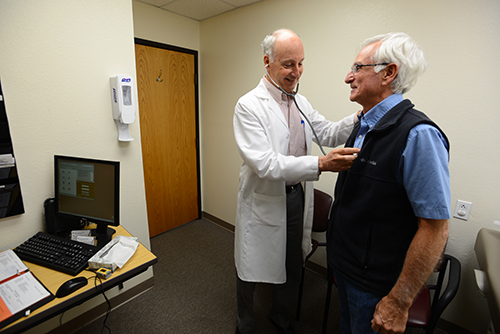Preparing for Disaster: UNM Hospital Participates in Region-Wide Emergency Training

Clearing The Air
UNM School of Medicine Aims to Help Adult Asthmatics
Many people think of asthma as primarily a childhood disease, but the American Lung Association reports that one in 12 adults currently suffers from it.
While childhood asthma symptoms are sporadic, adult-onset asthma symptoms are more likely to be persistent and less well controlled, especially in women, according to Michelle Harkins, MD, a physician in the Division of Pulmonary, Critical Care & Sleep Medicine in the University of New Mexico School of Medicine.
So, what makes one develop asthma as an adult?
“We don’t really know all the variables of adult-onset asthma,” Harkins says. “There are a number of factors. It might be a response to environmental irritants over time, occupationally induced or just late presentation. People with allergic issues are three times more likely to develop lower airway symptoms at some point in their life.”
Physicians speak of “asthma trigger” that can launch an attack. About half of those diagnosed with asthma also suffer from allergies. Commonplace workplace and environmental irritants can also be culprits.
People prone to developing adult-onset asthma range from women who take estrogen following menopause for more than 10 years to those who frequently get the flu and colds to those with gastroesophageal reflux disease (GERD).
The UNM Adult Asthma Clinic staff seeks to provide a comprehensive approach that can keep patients out of the emergency room, Harkins says, and that starts with education.

Treatment plans are a key to keeping asthma symptoms in check and fighting flare-ups
“Treatment plans are a key to keeping asthma symptoms in check and fighting flare-ups,” Harkins says.
The Adult Asthma Clinic began by identifying patients with severe asthma and a history of frequent ER visits and then sought to reduce repeat ER visits by creating a team that both medical staff and patients could rely on, she says.
“We were able to refer patients back to their primary physicians or to education specialists,” Harkins says. The specialists could provide information on the disease process, as well as things such as how to properly use an inhaler, she says.
The resulting statistics were impressive. A study after the clinic’s first year saw asthma readmissions to the ER cut in half.
The COVID-19 pandemic has affected asthma clinic staffing, but patients can still be referred for asthma education. In addition, today’s patients can also be considered for biologic therapy as well as participation in clinical trials and other research projects.
Working with educators and physicians can lead to fewer trips to the ER – and a higher quality of life for patients, Harkins says